In theory the undergraduate course of study at medieval universities was based on the seven liberal arts, the trivium–grammar, rhetoric, logic–and the quadrivium–arithmetic, geometry, music, and astronomy. What was actually taught at individual universities often deviated from this curriculum. One of the changes that took place was that other subjects were often added to the quadrivium.
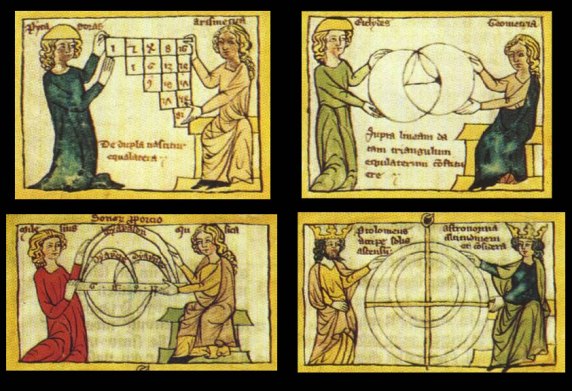
One subject that became very much a standard part of the quadrivium was the study of optics. This came about largely as a result of the influence of the work of Robert Grosseteste (1168–1253), who, drawing on the theory of radiation propagated by the Arabic polymath al-Kindi (C. 801–873) in his De radiis stellarum, “that everything in the world … emits rays in every direction, which fill the whole world”, made optics a central part of his cosmogony, believing light to be the first form of all things, the source of all generation and motion. Following Grosseteste, Roger Bacon (c.1220–c. 1292) also made optics a central part of his work drawing heavily on the Kitab al-Manazir (Book of Optics) of Ibn al-Haytham (c.965–1040), which had been translated into Latin by an unknown translator in the late twelfth or early thirteenth century, under the title De aspectibus.Ibn al-Haytham produced a synthesis of an intromission theory of vision with the geometrical optics of Euclid, Hero of Alexandria and Ptolemaeus. Vision is a result of light reflected from external objects entering the eyes. A very modern theory, whose only fault was that he believed that the image was formed in the lens of the eye. Both John Peckham (c.1230–1292), a later Archbishop of Canterbury, and Witelo (c. 1230–1280) produced works on optics based on Bacon’s transmission of al-Haytham, Peckham Perspectiva communis and Witelo Perspectiva around 1270, and these became the standard university textbooks.

This became known as Perspectivist theory, and there was very little change in this situation in the universities down to the sixteenth centuries. For example, when Regiomontanus (1436–1476) finally got awarded his MA, i.e., his permission to teach, at the age of 21, the first lecture course he held was on optics.
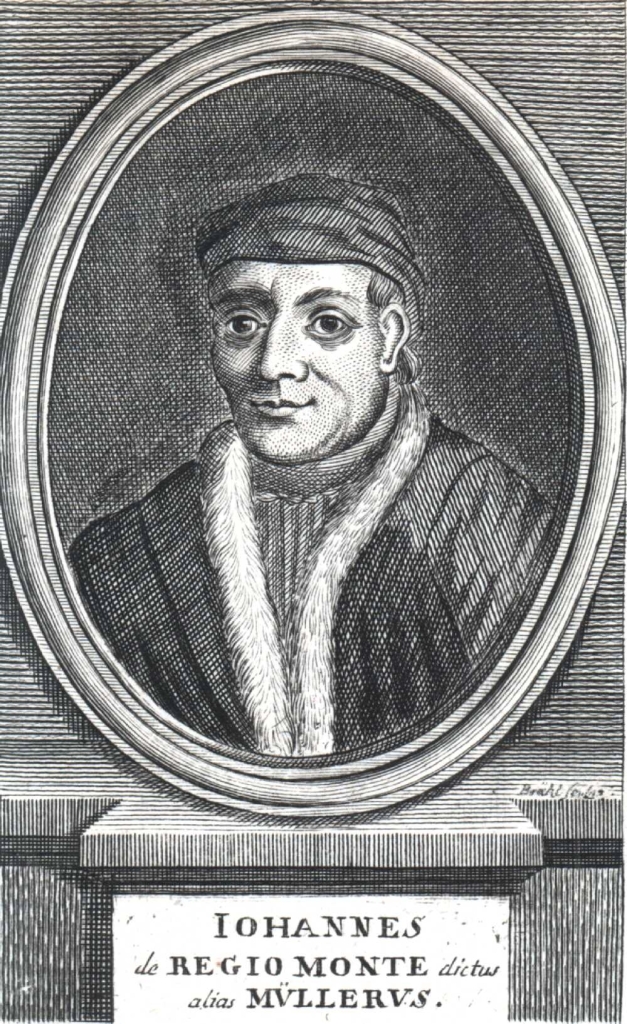
An interesting phenomenon is that around the same time as Bacon et al were creating the Perspectivist theory of optics, Eyeglasses were invented in Italy but there was no known connection between the two creations. The currently accepted theory, formulated by the Swiss historian of optics, Ralf Willach, is that medieval monks grinding and polishing precious stones to decorate the reliquaries made to hold saints’ relics, realised that these could be used to magnify texts.
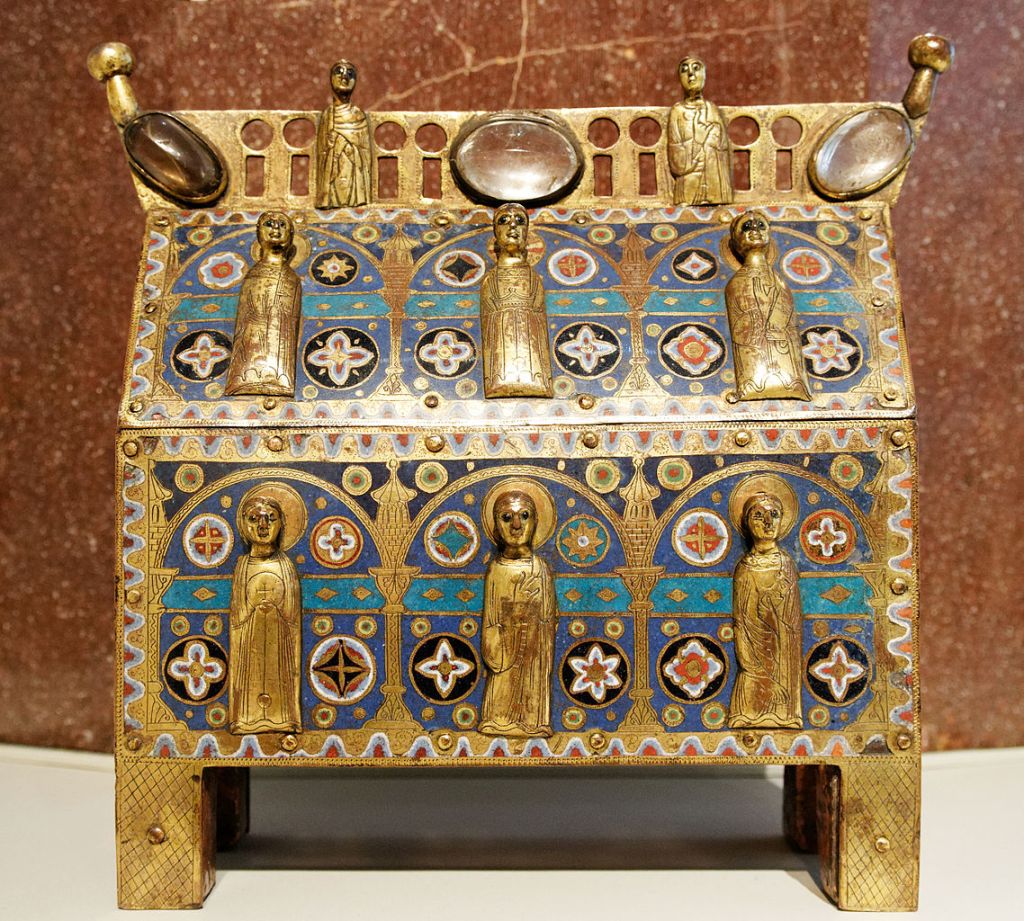
So, they ground pieces of quartz, and later glass, to the same size and shape to aid colleagues in the scriptorium, who suffered from presbyopia, age-related farsightedness, and so the pair of glasses was born. Willach undertook extensive optical measurements of both early eyeglasses and the precious stones on shrines to support his thesis. The development of eyeglasses continued, over time, independently of any optical theory taught at the universities and by the middle of the fifteenth century eyeglasses were available for all three of the common eye disorders.
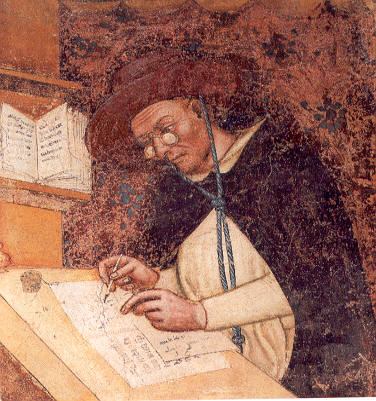
The next major development in optics was the invention of linear perspective at the beginning of the fifteenth century. Many sources claim, incorrectly, that this derives from al-Haytham’s theory of vision. However, linear perspective utilises Euclid’s geometrical optics and Alberti (1406–1472) states quite clearly in the first written account of linear perspective, his De pictura (1435), that for the theory it is irrelevant whether one holds an intromission, rays entering the eye, or extramission, rays projected out of the eye, theory of vision.
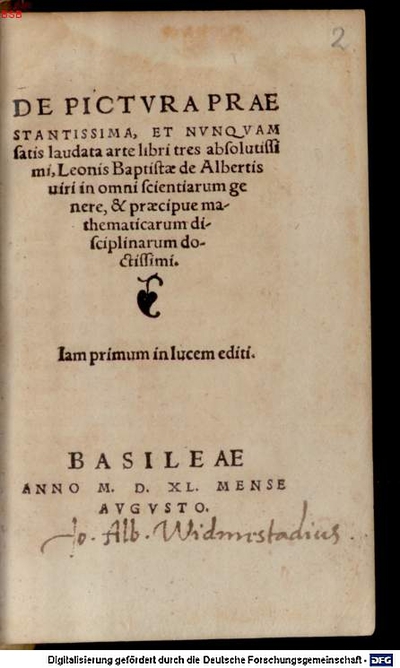
It was first in the sixteenth century that things began to gradually change in the field of optics, driven by three principal factors, Firstly, the increased interest in astronomical observations, secondly the invention of the printed book, and lastly the Renaissance developments in the discipline of medical anatomy.
Astronomical observations are by their very nature optical and observational astronomers already became aware in antiquity of the problem of atmospheric refraction i.e., the light rays coming from outer space are refracted, bent, by the Earth’s atmosphere.
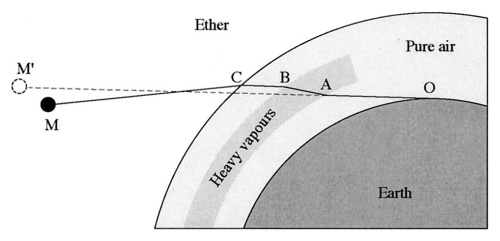
This is what prompted Ptolemaeus (fl. c. 150 CE) to write his Optica, an extensive investigation of a very wide range of optical phenomena and considered one of the three most important works on optics, alongside al-Haytham’s De aspectibus and Kepler’s Astronomia Pars Optica(1604), (about which much more later) before Huygens, Newton et al. Ptolemaeus apparently ignored atmospheric refraction in his Mathēmatikē Syntaxis but discusses it quite extensively in his Optica, which was written later. The reason Ptolemaeus gave for not calculating atmospheric refraction was that he didn’t know how deep the atmosphere was. The eleventh century Muslim mathematician Ibn Mu’adh (989–1079) did calculate the depth of the atmosphere based on his estimate how low below the horizon the Sun was when the light coming from it still was brighter than that coming from the opposite direction. Taking 19° as his value he calculated the atmosphere to be 86.3 km deep. A surprisingly accurate figure. Al-Haytham’s account of atmospheric refraction, in his De aspectibus, closely follows that of Ptolemaeus.
In the early modern period the question of atmospheric refraction, the law that governs it and how to measure or determine it became more important, as astronomers turned once again to making their own extensive observations. Copernicus, who was not really an observational astronomer, and took nearly all of his observed values from others, simply ignored the problem. However, for Tycho Brahe, a fanatic for accuracy, correcting for atmospheric refraction was an important issue. He conducted a long sequence of measurements based on a series of assumptions, for both the Sun and the fixed stars and achieved excellent results.
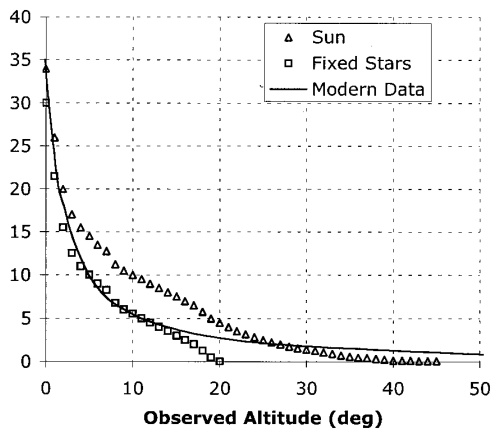
Determining the law of refraction became a pressing issue for many mathematicians and astronomers around the beginning of the seventeenth century. Strangely, Thomas Harriot carried out an extensive correspondence with Johannes Kepler on the issue without once revealing that he had in fact found the correct law.
We now turn our attention to the affect that the invention of movable type printing had on the debate about optics in the sixteenth century. John Peckham’s Perspectiva communis, a comparatively simple optics textbook, was published in Milan already in 1482/3 and went through nine separate editions before the end of the sixteenth century.
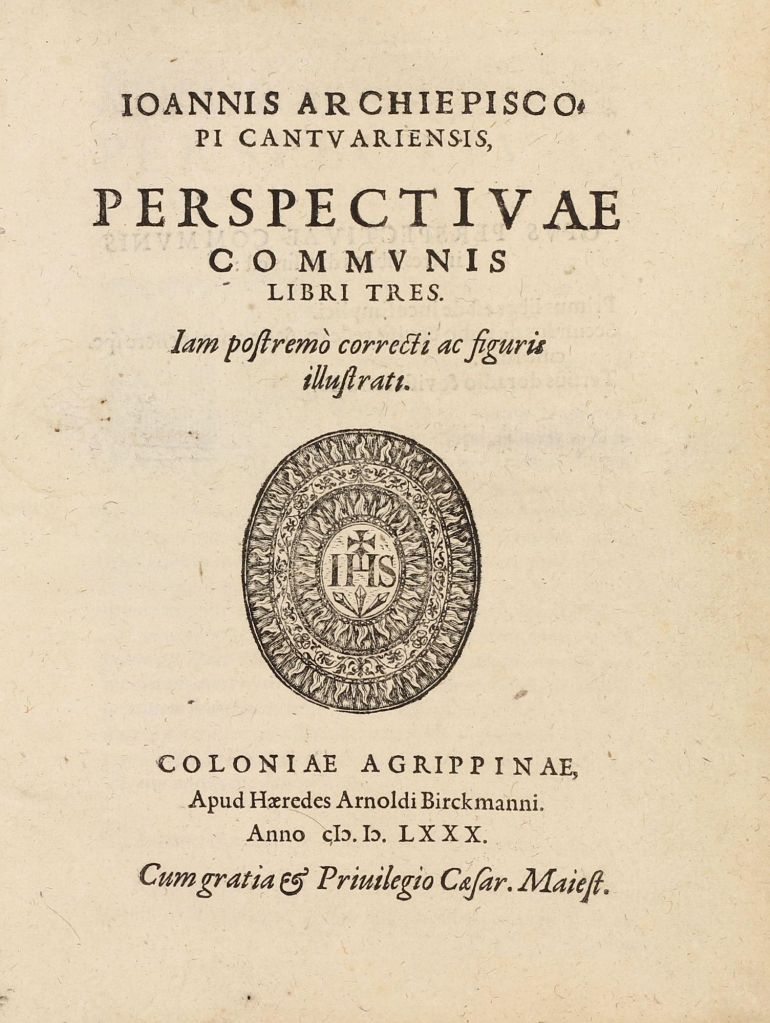
The first printed edition of Witelo’s Perspectiva, edited by Georg Tannstetter and Peter Apian, a much more advanced text that Peckham’s was issued by Johannes Petreius in 1535.
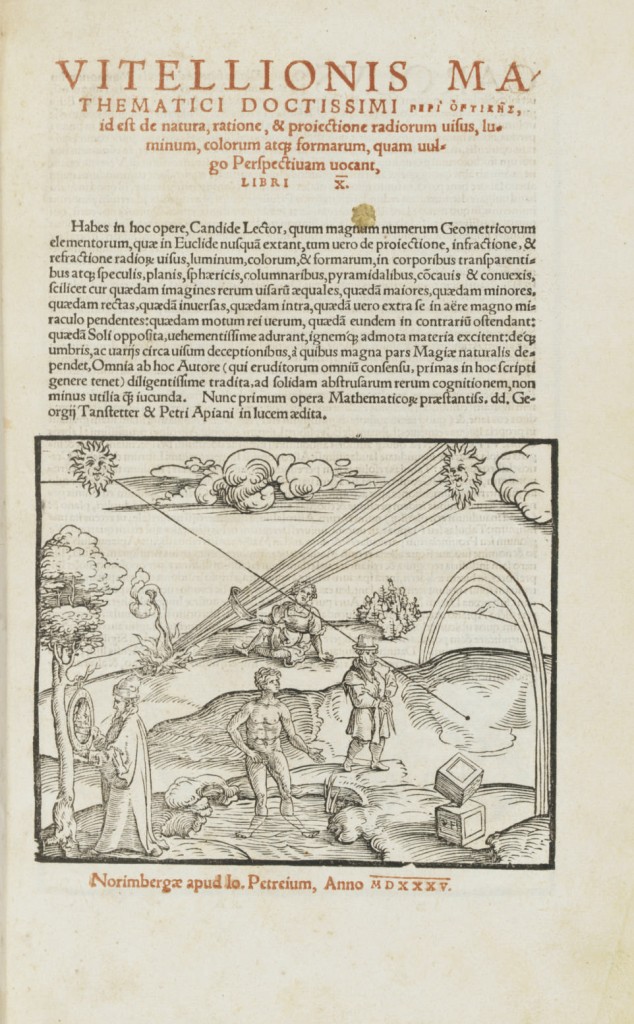
This was obviously well received as a second edition followed in 1551. The interest in optics was obviously growing as Friedrich Risner (c. 1533–1580), who was a pupil of Petrus Ramus and the first professor of mathematics on the Collège Royal de France in 1576, published his majestic Opticae thesaurus: Alhazeni Arabis libri septem, nuncprimum editi; Eiusdem liber De Crepusculis et nubium ascensionibus, Item Vitellonis Thuringopoloni libri X, (Optical Treasury) which as the title states contains both al-Haytham’s De aspectibus, printed for the first time, and the third edition of Witelo’s Perspectiva.

As I outlined in the XVIII and XIX episodes of this series there was a gradual development in the study of medical anatomy, which had its beginnings in the High Middle Ages and accelerated with the publication of Vesalius’ De Humani Corporis Fabrica in 1543.
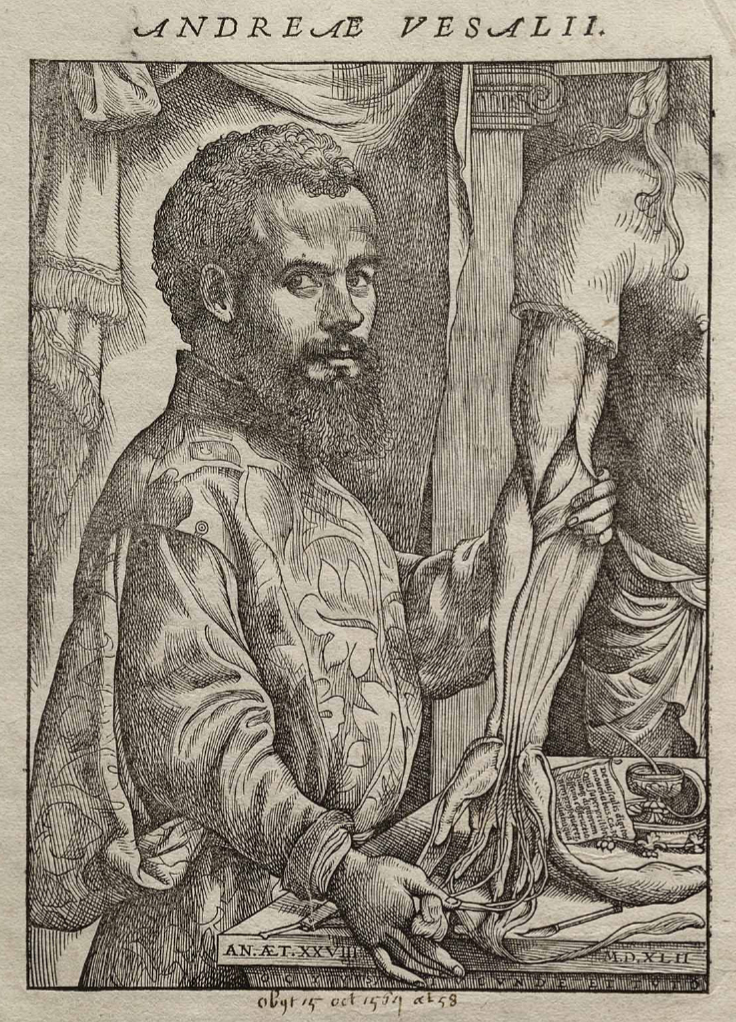
This was followed by the work of other North Italian anatomists such as, Gabrielle Falloppio (1523–1562) and Matteo Realdo Colombo (c. 1515–1559). Vesalius (1514–1564) produced the first accurate description of the eye, based on dissection since Galen (129–c. 216 CE).
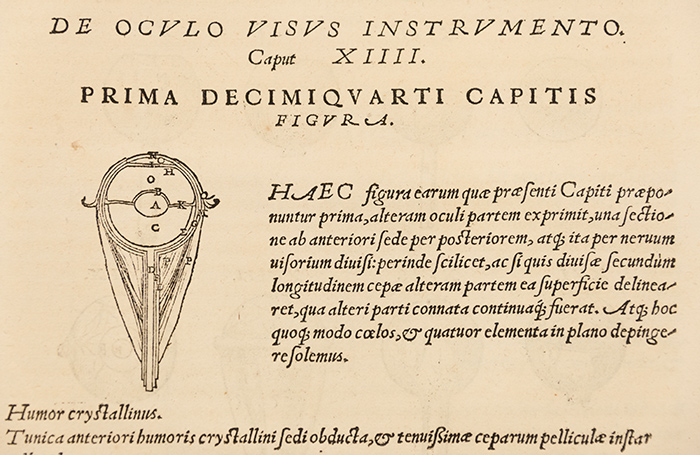
Al-Haytham used Galen in his work, and this was the model and concept that was adopted and propagated by the European perspectivists. In 1583, the Swiss physician Felix Platter (1536–1614), professor for medicine at the University of Basel,
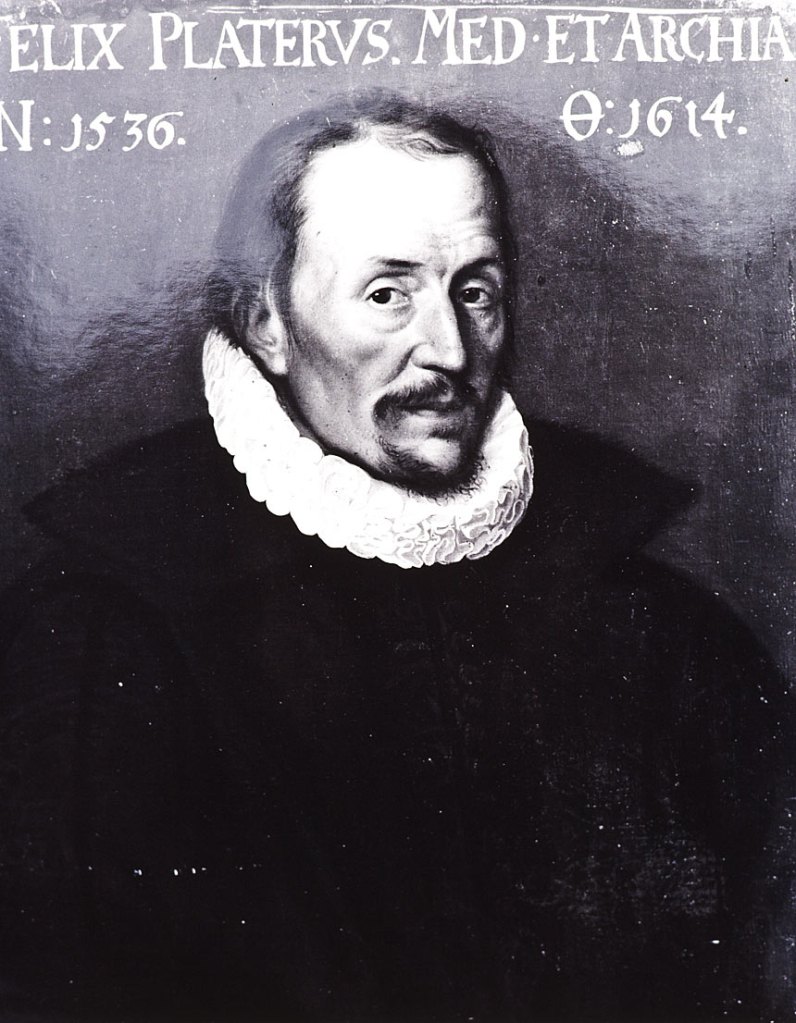
published a short text, De corporis humani structua et usu … libri III, aimed at popularizing, correcting, and supplementing the work of Vesalius, Colombo, and Falloppio, which consisted of fifty plates and text.
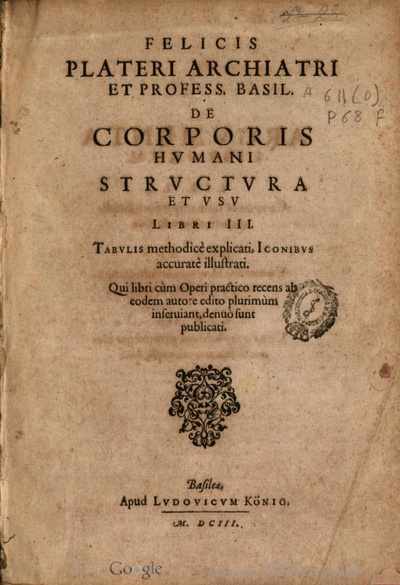
In his description of the eye, he declared the lens of the eye to be simply that, a lens, which collects the incoming rays and spreads them over the retina or retiform nerve. This stand into contradiction to the perspectivist view that the image in formed in the lens.
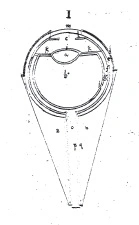
The three streams that I have described, the problem of atmospheric refraction, the publication of printed versions of the main perspectivist texts, and Platter’s new view of how the eye functions came together in the work of Johannes Kepler (1571–1630), who created a new theory of vision, whilst also bringing together the theoretical concepts of the perspectivists and the work of the craftsmen, who manufactured the eyeglasses.
Kepler’s journey to his new theories of optics began, when he became Tycho Brahe’s assistant in Prague and first confronted the problem of atmospheric refraction, which was so central to Tycho’s work. Motivate by this astronomical problem Kepler made an extensive and deep study of Risner’s Optical Treasury, and also read Platter’s De corporis humani structua. The result was his Ad Vitellionem paralipomena, quibus astronomiae pars optica traditur; potissimum de artificiosa obseruatione et aestimatione diametrorum deliquiorumque solis & lunae. Cum exemplis insignium eclipsium. Habes hoc libro, lector, inter alia multa noua, tractatum luculentum de modo visionis& humorum oculi vsu, contra opticos & anatomicos, authore Ioanne Keplero, to give it its full title, published in Frankfurt in 1604 and commonly referred to as Astronomiae pars optica, or simply Pars Optica, although the beginning of the title Ad Vitellionem paralipomena translates as Addition to Witelo.
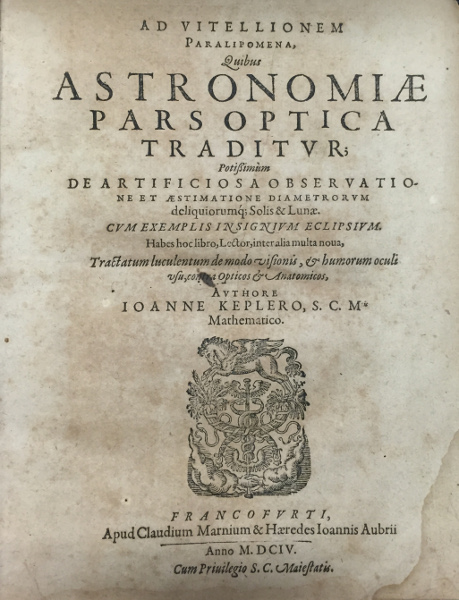
Weighing in at almost five hundred pages it is as long as the text to which it is supposedly additions. Kepler’s volume is one of the most important publications in the history of optics and either, spells the end of the perspectivist era, according to David C. Lindberg, or the start of the modern era of optics, according to A. Mark Smith. I’ll be catholic and say it probably does both.
Kepler’s work is far too extensive to deal with in detail here, so I’ll just sketch some of the greatest hits. Firstly, it contains a new theory of vision in which all the light rays entering the eye are focused by the lens, which creates an image on the retina. The eye function like a camera obscura, a term that Kepler coined, with a lens. The image in then transmitted to the brain along the optic nerve. This differs substantially from al-Haytham, who argued that only light rays which met the lens perpendicularly contributed to the image which was created in the lens itself. Kepler was aware that this would mean that the retinal image was inverted. He speculated, correctly, that the brain using its tactile knowledge of the real world would re-invert the image. The Jesuit mathematician, Christoph Scheiner (1573–1650), extended Kepler’s work, confirming the existence of the retinal image by peeling off the back of a bull’s pupil, publishing his results in his Oculus hoc est: Fundamentum opticum in 1619.
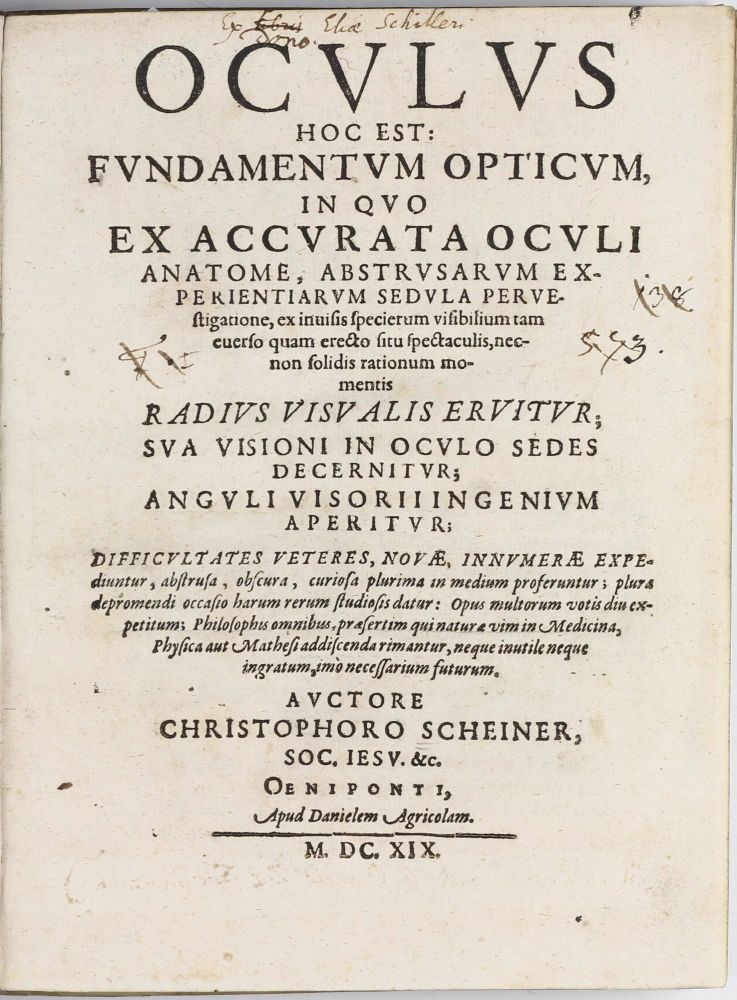
Kepler made an extensive analysis of the properties of lenses and gave the first published account of how the various lenes combined with the eye corrected short-sightedness and long-sightedness, bringing together optical theory and artisanal practice. This analysis would stand Kepler in good stead following the invention of the telescope.
Kepler solved the so-called pinhole camera problem in which the image of the moon, for example, created by a camera obscura is larger than it should be. He solved the problem using a method taken from Dürer’s descriptions of how to create linear perspective. Kepler drilled a hole in his desk and then suspended a book above to hole and using strings to replicate the light rays, the idea he took from Dürer, he demonstrated that what one had was not one image but a series of overlapping images, thus creating an image that was too large.
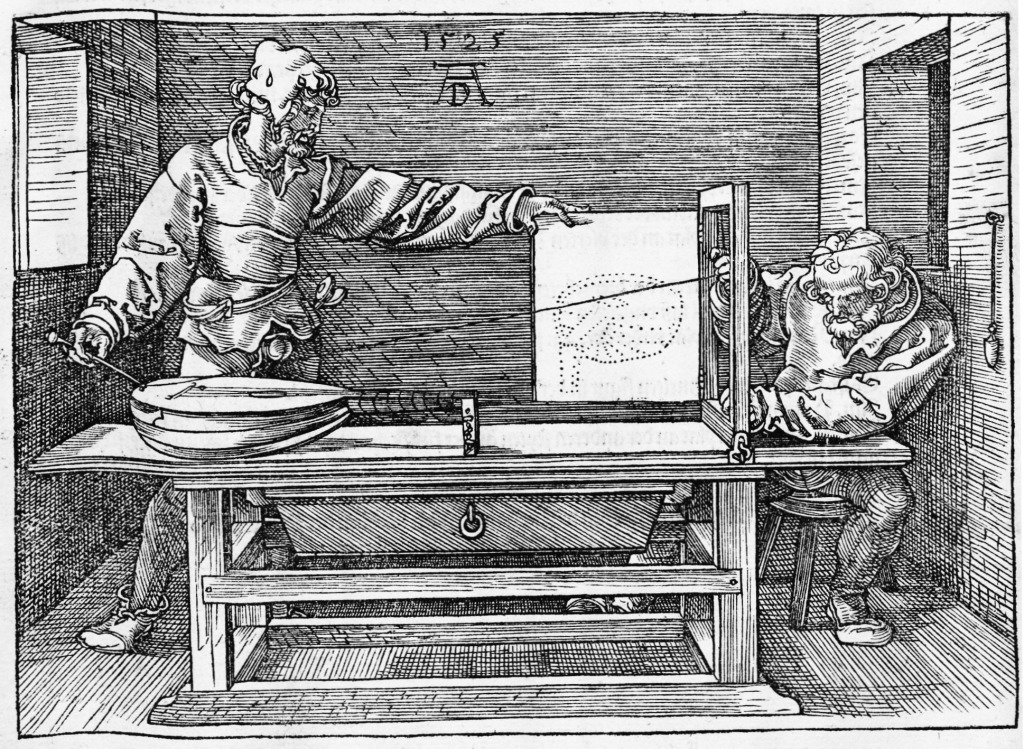
Another very important discovery in the Pars optica, is the inverse square law governing the intensity of light. This is often credited with being the first mathematical law in modern physics. Later Ismael Boulliau (1605–1694) argued by analogy that if there was a force emanating from the Sun, which drove the planets around their orbits, as Kepler had argued in his Astronomia Nova (1609), then it would also be governed by an inverse square law. This was the first instance of the law of gravity, which however, Boulliau, himself, rejected.
What is notably missing from the Pars Optica is, of course the law of refraction. As noted above in the first decade of the seventeenth century there was an intensive correspondence between Kepler and Thomas Harriot (c. 1560–1621) on optics and refraction in general, in which Harriot never mentioned that he had already discovered the law of refraction. This exchange shows that Kepler was not some sort of lone genius rewriting the book on optics, but others were interested in updating and improving the perspectivist canon. As we have seen Scheiner was, but his work came slightly later, largely inspired by Kepler’s work. Harriot’s work was independent of Kepler, but as with everything else he did, Harriot never published, so his pioneering efforts remained unknown and had no influence.
However, there were in the later part of the sixteenth century others who produced interesting work in optics before Kepler. As well as his Optical Treasury, Risner wrote his Opticae libri quator, a concise and clear presentation of the perspectivist optical theories, co-authored with his teacher and mentor Petrus Ramus (1515–1572), which was first published posthumously in 1606.
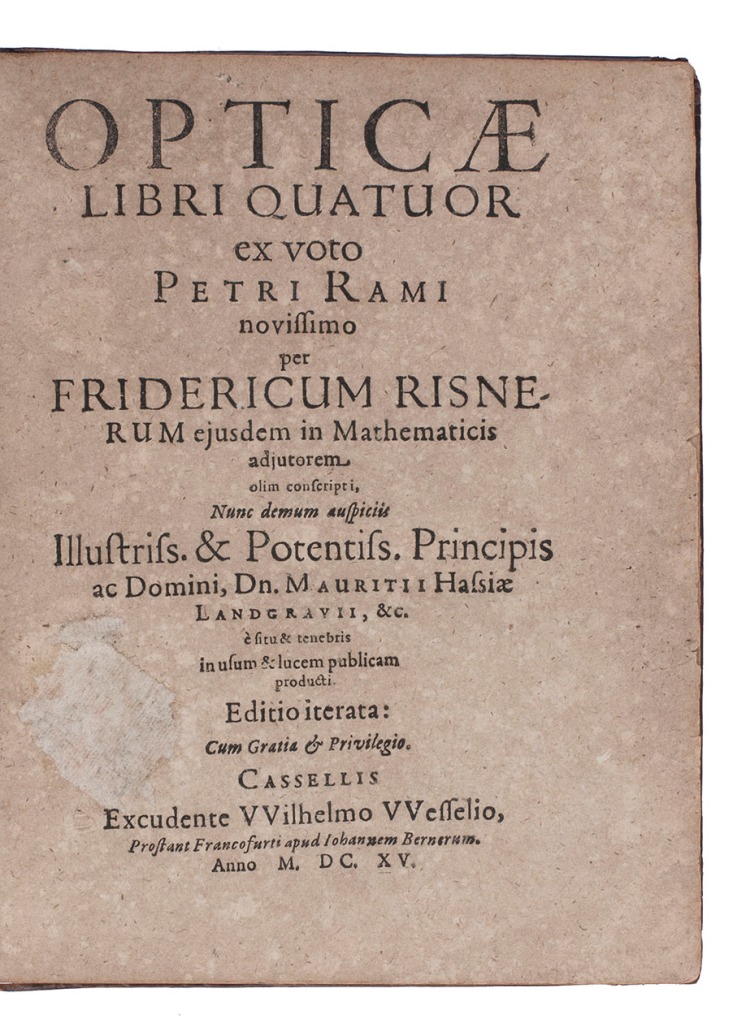
It influenced the work of Willebrord Snell. More interesting was the work of Francesco Maurolico (1494–1575). Already in the 1520s he wrote a book on refraction, Photismi de lumine et umbra, which anticipated much of Kepler’s work on lenses and the eye and explained how spectacles work.
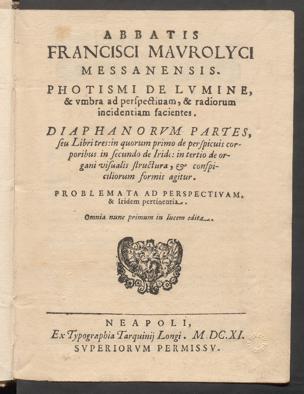
This work was, however, first published posthumously in 1611, so Kepler gets the credit for priority. Lastly the Italian polymath, Giambattista della Porta (1535–1615), who included quite a lot of optics in his monumental Magia Naturalis, which went from one volume in 1558 to twenty volumes in 1589. He also published a separate work on refraction, De refraction optices in 1589, which is a rather poor work in traditional perspectivist optics but regarded the eye, like Kepler, as a miniature camera obscura. However, although he did much to popularise the camera obscura with lens in his Magia Naturalis, he, unlike Kepler, did not draw the conclusion the eye lens focuses the incoming light rays but still thought that the image was created by the lens. Kepler had read the Magia Naturalis but complained that he couldn’t acquire a copy of della Porta’s De refraction optices. Interestingly della Porta has a description, in his Magia Naturalis of a small instrument that has the same lens configuration as the Dutch or Galilean telescope but appears to be a magnifying eyeglass rather than a telescope.
With a concave you shall see small things afar off, very clearly; with a convex, things neerer to be greater, but more obscurely: if you know how to fit them both together, you shall see both things afar off, and things neer hand, both greater and clearly.
He provided a primitive sketch in a letter to Prince Cesi in 1609.
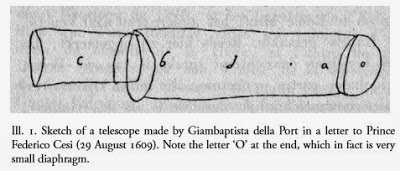
Kepler, however, attributed the invention of the telescope to della Porta, arguing that the information had somehow reached the spectacle makers in Holland.
One of the ironies of the history of optics is that although both Maurolico and Kepler had combined the practical artisan knowledge of the lens makers with the theoretical knowledge of the scholar, it was the artisan spectacle maker Hans Lipperhey (c. 1570–1619), who invented the most important optical instrument of the Early Modern Period, the telescope, in 1608
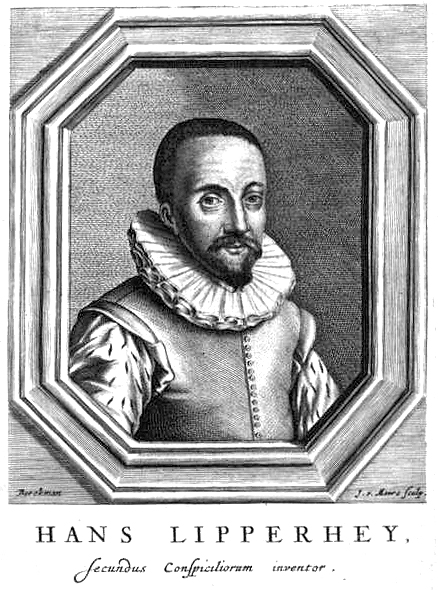
However, when people questioned how the telescope functioned and if one could trust the images it produced, it was Kepler building on the work on lenses that he had already produced in his Pars optica, who quickly explained the function of the telescope in his Dioptrice published in 1611, which it should be noted Galileo dismissed as unreadable.

The seventeenth century saw the development of the modern science of optics in the hands of Scheiner, Snell, Descartes, Huygens, Hooke, and Newton amongst others. All of them building on the work of Kepler, although Risner’s Optical Treasury remained an important textbook for most of the century.